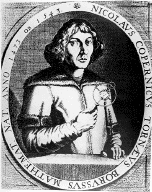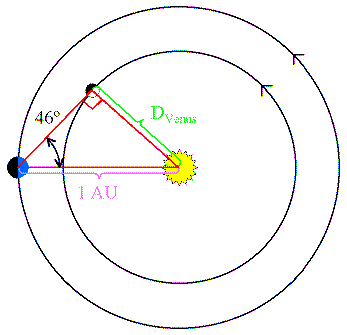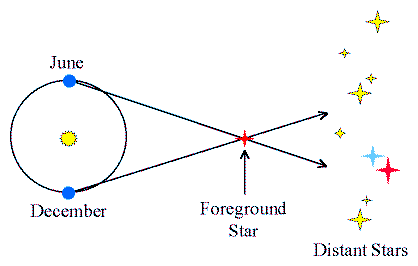

|
Astronomy 161:
An Introduction to Solar System Astronomy
Prof. Richard Pogge, MTWThF 9:30
|
Lecture 14: "The Revolutions" of Nicolaus
Copernicus
"If the Lord Almighty had consulted me before
embarking upon the Creation, I should have recommended
something simpler."
Alfonso X El Sabio [The Wise], of Castile (1221-1284)
upon being instructed in the Ptolemaic system.
Key Ideas:
The Medieval Interruption
Copernicus' Heliocentric System:
- Earth rotates on its axis once a day.
- Earth & Planets revolve around the Sun.
- Retained epicycles, but purged Ptolemy's equant,
restoring uniform circular motion.
Scientific Objections:
- "Impossibility" of a moving earth
- Non-observation of stellar parallaxes
The Great Interruption
Most classical knowledge was lost, or only dimly remembered, in Europe
after the fall of Rome c. 400AD.
However, the rise of a brilliant Islamic civilization in the Middle East
c.750AD led to survival of classical learning in Arabic translation:
- The Baghdad-Abbasid caliphs sponsored the work of systematically
translating classical Greek and Syraic texts into Arabic in the 9th
century (e.g., the famous "House of Wisdom" of the Baghdad Caliph
Abu al-Abbas al-Ma'mun).
- Islamic scholars not only preserved these older works, they also
advanced knowledge themselves with original discoveries in
mathematics & astronomy,
- This included the invention of algebra & advancement of
trigonometry, and fundamental work in optics, astronomy, geography,
and medicine.
In this way, the ancient classical learning was to be nurtured and
extended by Islamic society while most of contemporary Europe fell into
a kind of intellectual slumber.
European Rediscovery
Spain became the center for translation of Arabic texts into Latin in
the 11th century.
- Primarily the work of Jewish scholars working between the Christian
and Islamic worlds.
- The principal centers of this work were the magnificent libraries of
Toledo and Córdoba.
As these works made their way out of Spain, Europeans slowly
rediscovered their intellectual heritage:
- Aristotle & Ptolemy rediscovered in the 12th
century.
- Christian scholars (e.g., Aquinas) reconciled these with
works with the body of Christian dogmas (13th century)
In particular, the astronomy of Ptolemy, in the form of his Almagest
(the Arabic name of the Syntaxis), was to be elevated to
the almost to the level of religious dogma.
From Rediscovery to Rebirth
The period between the Middle Ages and the Renaissance were times of
great social and intellectual change:
- The rise of the great Universities.
- The invention and spread of printing.
- Challenges to the spiritual and political authority of
the Roman Church by reformers.
- Extended ocean voyages of discovery and trade by Portugal
and Spain.
Nicolaus Copernicus (1473-1543)

Born in Torun, Poland. Educated at Krakow, Bologna, and Padua in
mathematics, medicine, law, astronomy, & philosophy. Spent most of
his life as a Canon at Frauenberg Cathedral in Poland.
Copernicus was a very traditional thinker:
- Aristotelian in outlook.
- Conservative compared to his contemporaries (e.g., the humanist
philosopher Erasmus)
Copernicus' Discontents
Copernicus sought to purge Ptolemy's system of the messy expedient of
the Equant:
- It violated the Aristotelian notion of uniform circular
motion.
- He felt that a good system must please the mind as well as
"preserve appearances" (i.e., make accurate
predictions).
1514: Circulated a brief pamphlet, the
"Commentariolus", describing a new system of the
heavens.
Note: Copernicus was not alone in his discontent with the
Equant. Arabic astronomers in the 13th and 14th centuries undertook
reforms to the Ptolemaic model (specifically the
astronomer/mathematicians al-Tusi, al-`Urdi, and ash-Shatir), while
preserving its overall geocentric character.
The Heliocentric System Revived
Copernicus revived the Heliocentric system of Aristarchus, which he did
not know in detail, but rather through Archimedes' mention of it in
The Sand Reckoner.
- The Sun, not the Earth, is at the center.
- The Earth rotates around its axis, producing the daily
motions of celestial bodies.
- The Earth revolves (orbits) around the Sun, producing the
annual motions.
These were radical ideas for their time, but Copernicus was no
radical.
De Revolutionibus Orbi Coelstium
On the Revolution of the Heavenly Orbs (1543)
- The work was dedicated to Pope Paul III
- It was printed with the formal approval (Imprimatur) of Church authorities.
It was not, however, a bestseller:
- It was a long, difficult Latin treatise
- It was not widely circulated
Despite this, his ideas got serious attention, both for and against.
Far from being "the book nobody read" as it is often incorrectly
portrayed, De Revolutionibus was widely read and commented
upon by the scholars of the day, both for and against his ideas.
When is a revolution not a revolution?
Copernicus still clung to strict Aristotelian ideas in
his heliocentric system:
- It retained epicycles, if now they were centered on the Sun
instead of the Earth.
- It required uniform circular motion.
This made his system complex:
- 48 epicycles, compared to 40 in the Ptolemaic geocentric system.
- but, it did not use the complicated equant.
Still only described the motions of the planets without
explaining them physically.
One point, however, needs to be emphasized. The geocentric models of
Ptolemy and others described in Lecture 14
introduced epicycles in order to produce the observed retrograde motion
of the planets. In the Copernican system, retrograde motion comes
naturally, without resort to epicycles. While Copernicus' system does
not need epicycles to produce retrograde motion, because of his
insistance on uniform circular motion he still had to use them in order
to get his model to make accurate predictions (i.e., to "preserve
appearances") .
Simple in principle
While it was more complex in detail, the Heliocentric system does
lead to a considerable measure of conceptual simplification.
Herein lies its virtue. It explained naturally what was more
difficult to explain in the Ptolemaic system without things being "just
so" or highly contrived. Specifically...
Inferior and Superior Planets:
- Mercury & Venus orbit closer to the Sun
- Mars, Jupiter, & Saturn are in larger orbits.
Diagram of the Ptolemaic System (10Kb GIF)
Diagram of the Copernican Solar System (13Kb GIF)
In each, much of the detail of both systems has been stripped away to
show the basic arrangement of planets and orbits. The Copernican
diagram entirely omits the epicycles that Copernicus employed, opting
instead for a view of the true Solar System.
Retrograde Motion:
- Natural consequence of observing moving planets from a moving Earth.
- By contrast, Ptolemy's system required epicycles to
get retrograde motion.
- Copernicus still needed epicycles to reproduce the non-uniform
apparent speeds of the planets.

(Click on the image to view at full scale [Size: 11Kb])
Geometric Distances to Planets
The Heliocentric system's geometry provides a natural way to measure the
distances of the planets from the Sun.
Inner Planets:
- Use geometry of maximum elongation (see figure below)

(Click on the image to view at full scale [Size: 9Kb])
Outer Planets:
- Measure time from opposition to quadrature
- More complicated but quite tractable.
By contrast, you cannot estimate planetary distances with the Ptolemaic
system by simple means. You have to find them some other, arbitrary
way, if at all.
Results:
| Planet | Copernicus | Actual |
| Mercury | 0.376 | 0.387 |
| Venus | 0.719 | 0.723 |
| Earth | 1.00 | 1.00 |
| Mars | 1.52 | 1.52 |
| Jupiter | 5.22 | 5.20 |
| Saturn | 9.17 | 9.54 |
The distances from the Sun are only measured relative to the
Earth-Sun distance (the Astronomical Unit).
The problem was, neither Copernicus nor anybody else at the time knew
how big an AU (the mean Earth-Sun distance) was in everyday units to any
degree of precision. That is a another story for another day...
Opposition to Copernicus
The Copernican Heliocentric System met with almost immediate opposition.
Religious Objections:
- Luther, Calvin, & Melancthon objected on the ground
that a moving Earth contradicted scriptures.
- The Catholic Church was officially silent at first.
More detail about this may be found in A Brief
Note on Religious Objections to Copernicus. These were of less
immediate consequence and concern to Copernicus than the scientific
objections.
Scientific Objections
A rotating and revolving Earth was deemed an absurdity by strict
Aristotelians:
Both motions require very large speeds:
- Speed of rotation at Columbus: 1280 km/hour
- Orbital Speed: 107,000 km/hr = 30 km/sec!
There was no observational evidence of Earth's orbital motion:
- Stellar Parallaxes were not observed.
- Stars weren't brighter at opposition.
There was no observational evidence of Earth's rotation:
- Daily motions are as easily explained by a fixed earth.
- The motions do not require a rotating earth.
Copernicus was aware of these problems, but lacked the observational
tools to address them definitively.
The most important was the non-observation of Stellar Parallaxes.
Stellar Parallaxes
Parallax is the apparent back-and-forth motion of nearby stars
with respect to more distant stars caused by the changing perspective of
the Earth at is orbits around the Sun.

(Click on the image to view at full scale [Size: 7Kb])
The reason it was not observed is that the stars are much farther than
people thought at the time. We'll discuss this more in detail in an
upcoming lecture.
This was a powerful objection to the Heliocentric system. One that had
to be addressed to finally settle the issue.
The Power of Ideas
In detail, the Copernican System was flawed and unwieldy. It was
arguably only an incremental improvement over the Ptolemaic system,
insofar as it made somewhat better predictions of the positions of the
planets than the Ptolemaic calculations of the day, and it was somewhat
easier to use mathematically because it eliminated the difficult
artiface of the equant.
In practice, however, it made up for this by offering a considerable
measure of conceptual simplicity: many of the contrivances of the
geocentric system needed to explain retrograde motions and the
differences in the motions between inferior and superior planets were
eliminated.
In a world of increasing change, the idea behind it was to prove
powerful, and truly revolutionary.
Return to [
Unit 3 Index
|
Astronomy 161 Main Page
]
Updated: 2006 October 4
Copyright © Richard W. Pogge,
All Rights Reserved.



